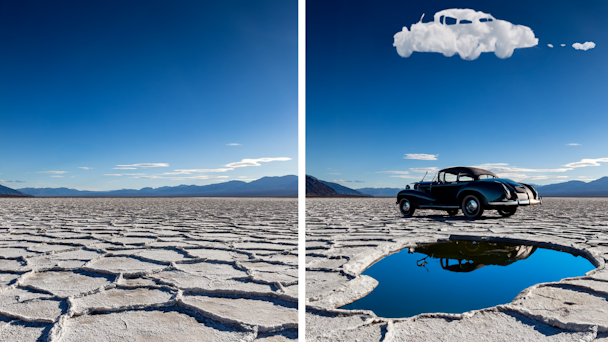New spate of generative AI platforms makes technology more accessible to marketers
Big tech companies like Adobe and Google, along with some smaller brands, are equipping advertisers with new, AI-powered tools. Meanwhile, marketing experts caution against viewing such tools as a replacement for human talent and creativity.

A before (left) and after (right) image displays the capabilities of Adobe's new Generative Fill feature on Photoshop. / Adobe
Over the past several months, generative AI – a subcategory of AI designed to create original content such as text and digital images from user prompts – has evolved within the marketing industry from an intriguing novelty to something of an obsession. At last month’s Cannes Lions festival, AI (and generative AI in particular) was the undisputed center of attention, with many major brands eagerly trying to show off their strategies for incorporating the technology.
But while many marketers have been excitedly chatting about generative AI and all of the various ways in which it could revolutionize their industry, much of that discussion has been rather abstract and hypothetical; the technology obviously has big implications for anyone who designs creative assets for a living, but it hasn’t been clear how exactly it could be practically integrated within marketing teams’ existing workflows and toolkits.
For a while, the best response that many brands have seemed to come up with in response to that question was to simply integrate popular ’genAI’ tools – such as ChatGPT, into their marketing campaigns or apps. Now, however, a new wave of creative tools are emerging which are making generative AI more user-friendly and accessible than ever.
Advertisement
Adobe, for example, recently made headlines by announcing that Firefly – the company’s suite of generative AI tools that was unveiled in a beta for enterprise version back in March – had been integrated into Photoshop. ”Generative Fill,” as the Firefly-powered feature was dubbed, “is the world’s first co-pilot in creative and design workflows, giving users a magical new way to work by easily adding, extending or removing content from images non-destructively in seconds using simple text prompts,” the company wrote in a press release.
Shortly after announcing the Photoshop news, Adobe also announced that it had also integrated Firefly (still in beta) into its Express and Illustrator platforms.
Last month, TV marketing platform Mntn announced the upcoming launch of Viva, a video editing platform for marketers that leverages generative AI tech from industry leaders like OpenAI (the company behind ChatGPT) and ElevenLabs (a company that builds AI-powered text-to-speech software). “Generative AI will bring a new level of speed and lower cost to everything from script creation to storyboarding, to getting those seconds of video you wish you shot,” Mntn president and CEO Mark Douglas said in a statement. “You’ll see multiple versions of video in the time it takes to create one version now.”
Advertisement
The list goes on. Google recently announced Product Studio, a free platform powered by generative AI which enables Google Shopping clients to touch up product images. (Google, along with Microsoft, has also been working on integrating generative AI into its search function.) Another AI-powered software company called Omneky gives marketing teams the ability to “launch hundreds of thousands of ad iterations across all platforms, from TV to TikTok, with the click of a button,” according to a tutorial video on the company’s website. The company says it also uses OpenAI’s GPT large language model to “write infinite amounts of personalized ad copy for you, allowing you to scale to more audiences.”
The rapid and escalating integration of generative AI into creative marketing platforms – both mainstream and up-and-coming – is likely to have a profound impact on the advertising industry as a whole, according to PJ Pereira, founder and chief creative officer of Pareira O’Dell. “The integration of AI into Photoshop [is] there,” he says. “From now on, every art director who uses Photoshop is using AI.” In Pereira’s view, every aspect of the marketing workflow will eventually “have an AI element, which will transform every function of the business … I don’t think it’s just a matter of using less energy and human power – I think it’s going to allow us to explore so many ideas.”
Some experts are quick to point out, however, that generative AI tools are at present only as capable as the human being who’s operating them. Jim Lecinski, associate professor of marketing at Northwestern University and coauthor of The AI Marketing Canvas, compares the capabilities of generative AI platforms with the performance of a sports car: “[It] depends on the skill of the driver,” he says. “Tony Stewart or Mario Andretti could do a whole lot more with a Ferrari than I could.” Lecinski says that when he experiments with generative AI platforms (he personally prefers Stable Diffusion, a model which generates digital images from text-based prompts) “the results are pretty good.” When he looks at the work of “digital artists who do this for a living,” however, “it’s like drop-dead ‘Wow, this is better than anything in any agency photoshoot I’ve ever worked on in my life.’”
Suggested newsletters for you
Tessa Barron, vice-president of marketing at software company On24, similarly argues that AI should not be thought of as a replacement for human creativity. “When I think about great marketing, it always starts with positioning, it starts with messaging, it starts with the story we want to tell,” she says. “That’s not going to change – there’s just no substitute for it … while AI can help catalyze brainstorming and so on, it will not define the positioning or messaging your company initially has. But is it going to take that, run with it and produce multiple variations of it? One hundred percent.”
For more on the latest happenings in AI, web3 and other cutting-edge technologies, sign up for The Emerging Tech Briefing newsletter here.

